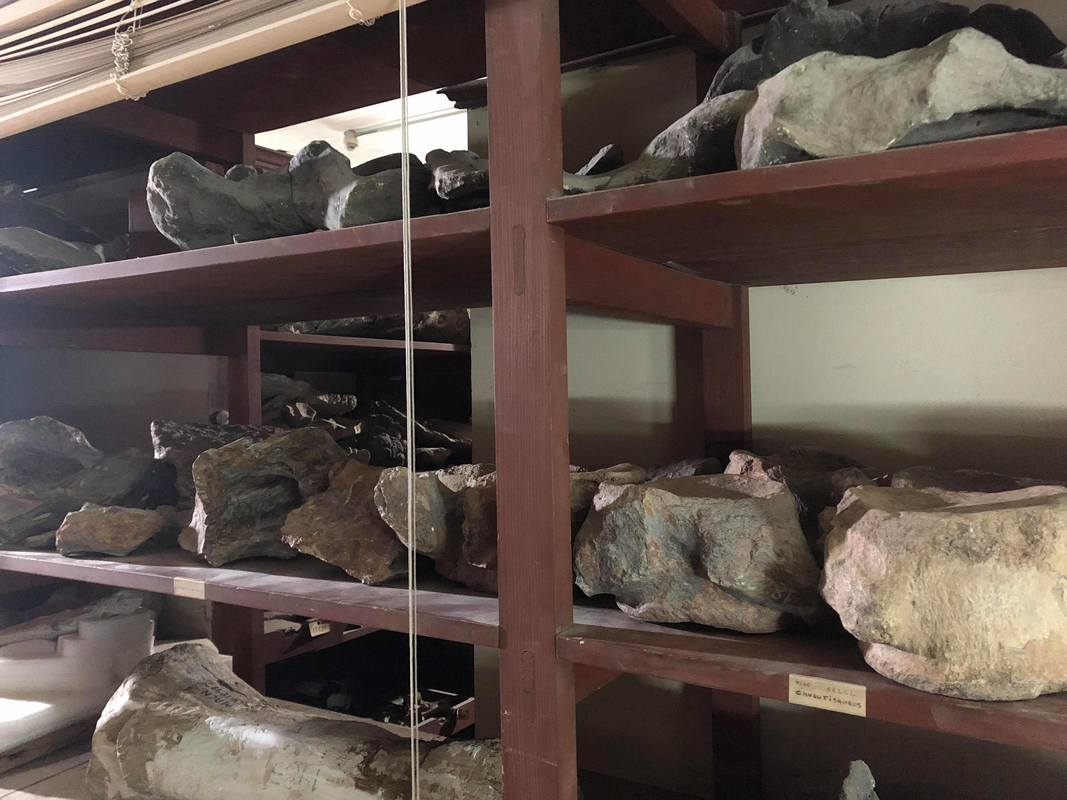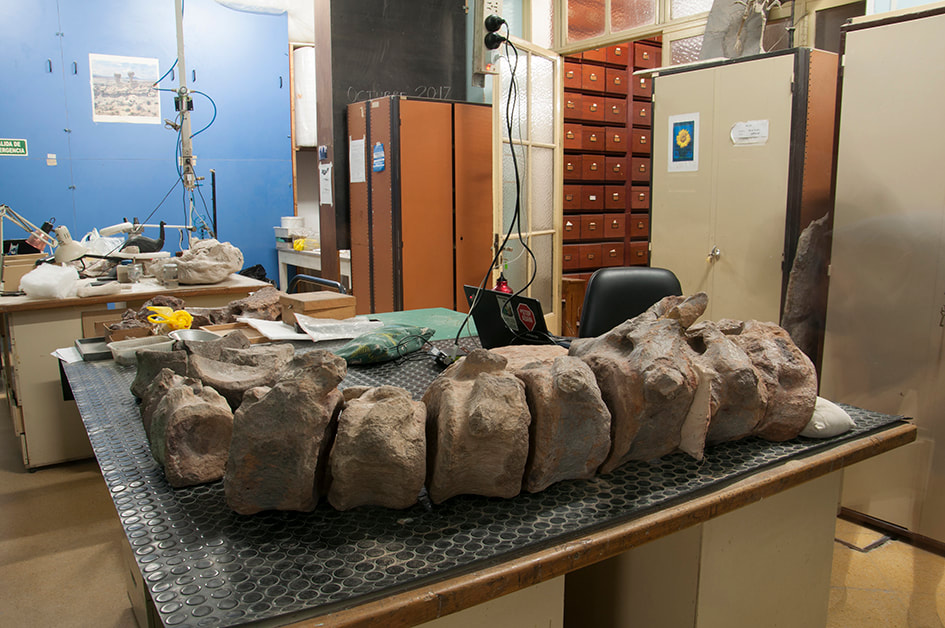|
Argentina was home to huge diversity of long- (and even some short-) necked sauropods during the Cretaceous Period (145–66 Ma). Indeed, the first dinosaurs named and described from Argentina were all sauropods — I might write more on them next week, since many of those specimens are housed at Museo de La Plata; that said, while there I have bigger (albeit literally smaller) fish to fry... It is fair to say that the true abundance and diversity of sauropods in the Argentinian Cretaceous has only really been revealed in the last thirty years or so, with the late Jaime Powell’s 1986 Ph.D. thesis (published in full in 2003) catalysing much of the subsequent research on titanosaurs in particular. Nevertheless, some very important Argentinian sauropods were named before Powell’s monumental manuscript, and one of these was Chubutisaurus insignis. Starting in February 1965, agronomical engineer Julio Fernández Duque and palaeontologist Guillermo del Corro spent 30 days excavating fossilised dinosaur bones from a site near Cerro Barcino and Cerro Winches in Chubut Province. The bones, which were first discovered by a local rancher named Mr Martínez (whose widow had informed Duque of their existence), were preserved in such hard rock that Duque and del Corro had to use dynamite in order to extract them. A substantial quantity of fossil material was recovered from the site, and all of the bones appeared to belong to a single sauropod dinosaur — except for five theropod teeth, which were named Megalosaurus inexpectatus by del Corro in 1966. All of these bones were deposited in the collections of the Museo Argentino de Ciencias Naturales in Buenos Aires, with the exception of two fragmentary limb bones that were donated to the Museo Provincial de Ciencias Naturales y Oceanografía in the 1970s. Ten years after the excavations took place, del Corro described and named the sauropod from Chubut as Chubutisaurus insignis (the “notable Chubut lizard”), which he classified in its own family, Chubutisauridae. However, del Corro illustrated only a small subset of the available material and misinterpreted several specimens. He also suggested that Chubutisaurus was Late Cretaceous in age, but provided little evidence to support this interpretation. His paper — preliminary by his own admission — would need to be followed up by a more comprehensive work down the line. In 1978, José Bonaparte and Zulma Gasparini highlighted the fact that Chubutisaurus was more “primitive” anatomically than the titanosaurs that were so characteristic of South America during the Late Cretaceous (100.5–66 Ma). Consequently, they suggested that Chubutisaurus was actually substantially older than suspected by del Corro; based on microfossils from the same formation that had been interpreted as Aptian in age (125–113 Ma), they suggested Chubutisaurus was actually from the Early Cretaceous. Twelve years later, in the Sauropoda chapter of The Dinosauria, John McIntosh illustrated several of Chubutisaurus’ limb bones and suggested that it was a brachiosaurid. However, it was not until 1993 that a more comprehensive, albeit still abbreviate, description was published by Leonardo Salgado. He suggested against classifying Chubutisaurus as a brachiosaurid, because he considered the anatomical features that McIntosh had used to link the two as shared “primitive” characters. However, Salgado did identify some features that could be used to link brachiosaurids, Chubutisaurus and titanosaurs, indicating a possible relationship between all three. In 1991, a few years before Salgado’s paper on Chubutisaurus was published, the Museo Paleontológico Egidio Feruglio (MPEF) launched a field trip to try to relocate Duque and Del Corro’s quarry. They were able to do so with the help of Mr Martínez’s son, who had been present when Duque and del Corro excavated the site in 1965. In 1991, and in 2007 as well, the MPEF team collected more material of Chubutisaurus — some of which had been transported some distance from their original positions by the force of the 1965 dynamite blasts. All of the material collected by the MPEF came to reside in the Museum in Trelew, meaning that the only known specimen of Chubutisaurus is now divided between three separate museums! A complete description of Chubutisaurus was only published relatively recently (2011) by José Carballido, Diego Pol, Ignacio Cerda and Leonardo Salgado. These authors concluded that Chubutisaurus was of Cenomanian age (~100.5–93.9 Ma) and that it was more closely related to titanosaurs than to brachiosaurs. Indeed, in both their analysis and in most recent analyses of sauropod interrelationships, Chubutisaurus is resolved as a basal somphospondylan — a close relative of titanosaurs, but not a true titanosaur itself. The material on which Chubutisaurus is based — which derives from the Bayo Overo Member of the Cerro Barcino Formation, Chubut Province — is extremely incomplete, although in fairness that is not a rarity for sauropods. The few thoracic vertebrae preserved suggest that those situated near the front of the chest — and therefore at the base of the neck — were quite short front-to-back but tall top-to-bottom. Further back in the sequence, the inverse holds true. Although no neck vertebrae were found, it can be inferred that the neck was quite long — partly because Chubutisaurus was a sauropod, for which long necks were the norm, but also because the short vertebrae at the front of the thorax were probably so short front-to-back (relatively speaking) to cope with the stresses imposed upon them by the movements of a long neck. By contrast, the tail of Chubutisaurus — although nowhere near complete — was presumably shorter than the neck: all of the tail vertebrae known are (again, relatively) short front-to-back. The tail vertebrae of Chubutisaurus are interesting for another reason: they are not procoelous. The centra (vertebral bodies) of procoelous vertebrae are concave on the front articular face and convex on the back one. However, those of Chubutisaurus are shallowly concave on the front face but essentially flat on the back face. This easily distinguishes the tail vertebrae of Chubutisaurus from those of most titanosaurs, the sauropods for which Argentina has become famous, because almost all of them have procoelous tail vertebrae; only in the most basal titanosaurs are the tail vertebrae not procoelous (as in the Australian Savannasaurus) or only incipiently so (as in the basalmost titanosaur by definition, Andesaurus). That'll do for now; once I have had a look at the girdle and limb bones of Chubutisaurus, I might have more to say... in the immediate future, however, I need to move on to another dinosaur — one from the southernmost continent of all! References Bonaparte, J.F. & Gasparini, Z.B., 1978. Los sauropodós de los Grupos Neuquén y Chubut, y sus relaciones cronológicas. Actas del VII Congreso Geológico Argentino, Neuquén, 1978 2, 393–406. Carballido, J.L., Pol, D., Cerda, I. & Salgado, L., 2011. The osteology of Chubutisaurus insignis Del Corro, 1975 (Dinosauria: Neosauropoda) from the ‘Middle’ Cretaceous of Central Patagonia, Argentina. Journal of Vertebrate Paleontology 31, 93–110. Del Corro, G., 1966. Un nuevo dinosaurio carnívoro del Chubut (Argentina). Museo Argentino de Ciencias Naturales (Bernardino Rivadavia), Communicaciones Paleontología 1, 1–4. Del Corro, G., 1975. Un nuevo saurópodo del Cretácico Superior, Chubutisaurus insignis gen. et sp. nov. (Saurischia, Chubutisauridae nov.) del Cretácico Superior (Chubutiano), Chubut, Argentina. Actas I Congreso Argentino de Paleontología y Biostratigrafía, 229–240. McIntosh, J.S., 1990. Sauropoda. In The Dinosauria. Weishampel, D.B., Dodson, P. & Osmólska, H., eds, University of California Press, Berkeley, 345–401. Powell, J.E., 1986. Revisión de los titanosauridos de América del Sur. Ph.D. thesis. Universidad Nacional de Tucumán, Tucumán, Argentina, 472 pp. (unpublished). Powell, J.E., 2003. Revision of South American titanosaurid dinosaurs: palaeobiological, palaeobiogeographical and phylogenetic aspects. Records of the Queen Victoria Museum 111, 1–173.
1 Comment
Solicitar un préstamo ahora
1/23/2024 10:47:50 am
Buenos días señor / señora,
Reply
Leave a Reply. |
Stephen PoropatChurchill Fellow (2017) on a palaeo-tour of Argentina! Archives
December 2018
Categories |



 RSS Feed
RSS Feed
